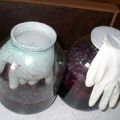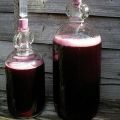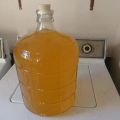Why do you need a glove on a can of wine and how to put it on correctly at home
A glove on a jar of wine is worn by beginners and experienced winemakers. This is the easiest way to limit the oxygen supply to the fermentation tank. Put it on the neck. By its appearance, the intensity of wort fermentation is determined. Gloves are used to make grape, apple, plum, cherry wine at home.
What is a glove for making wine
During the fermentation of grape, fruit and berry must, carbon dioxide is produced. If you close the fermenter with the lid, it will rupture the container. If you do not close the neck, oxygen will flow into the jar (bottle).
It will start oxidative processes in the wort, create favorable conditions for the reproduction of pathogenic microorganisms. The result will be disastrous. Homemade wine will turn to acid. The harmful bacteria will take care of this. They will convert the alcohol into acid.
Putting a glove on the fermentation tank solves these problems:
- it limits the supply of oxygen;
- does not miss the infection;
- inflating, gives an outlet to carbon dioxide.
By the appearance of the gloves, the intensity of fermentation is evaluated. It is active if it is inflated, all 5 fingers are raised up. It fades if it is limp. Stopped if the glove deflated and the fingers dropped down.
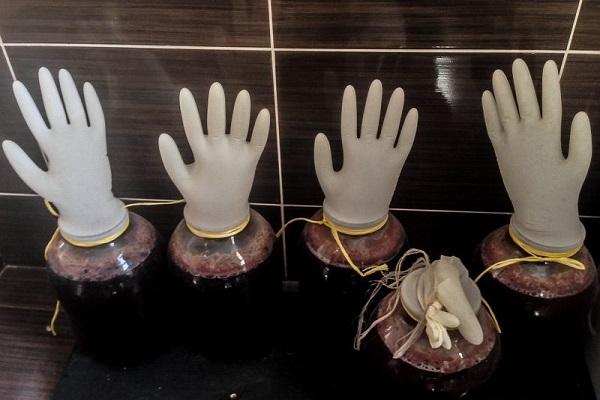
Preparation of grapes and dishes
The list of what is required to make homemade wine is not long. It includes:
- glass bottle (jar) - fermenter;
- buckets, containers made of food grade plastic;
- medical gloves;
- gauze;
- thin, long tube.
It is better for a budding winemaker to start with glass fermenters. They are easier to process before laying raw materials, they do not emit odors that spoil the finished product. It is convenient to observe the fermentation process.
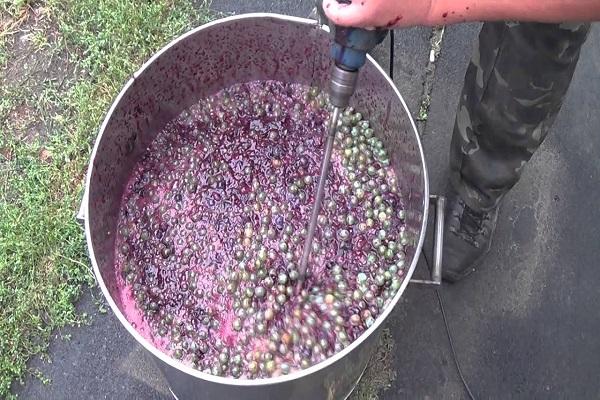
It is difficult to wash fermentation tanks. After making wine, dead fungi (sediment) remain at the bottom of the bottle, and plaque (tartar) forms on the walls. Experienced winemakers clean the containers as soon as the young wine is merged.
Processing nuances:
- the container is rinsed with clean water;
- 2-3 liters of warm clean water are poured, dishwashing detergent is added;
- rinse, completely remove the remaining detergent;
- pour 1 tsp. soda (with a slide), fill the bottle with water, rinse.
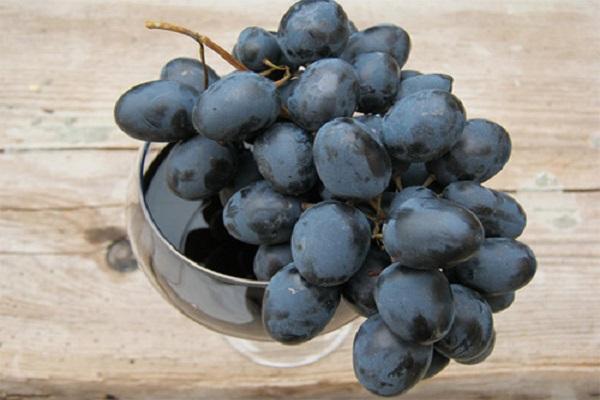
Remove plaque from the top of the bottle with a kitchen brush. The lower part is cleaned with a rag tied to a wooden stick. Wheat grains are well wiped off strong sediment. 2-3 glasses are poured into the bottom of it. Dry the clean container.Are engaged in the preparation of berries:
- The grapes are not washed, they preserve natural yeast on the skin, in the process of their vital activity they process fruit sugar into alcohol;
- brushes are cut off in dry weather, after rain, at least 2-3 days should pass in order for the concentration of sugar in the juice to increase;
- the berries are separated from the ridges, the spoiled (rotten, broken) are thrown away;
- raw materials are pressed with a wooden crush or a construction attachment (mixer) on an electric drill.
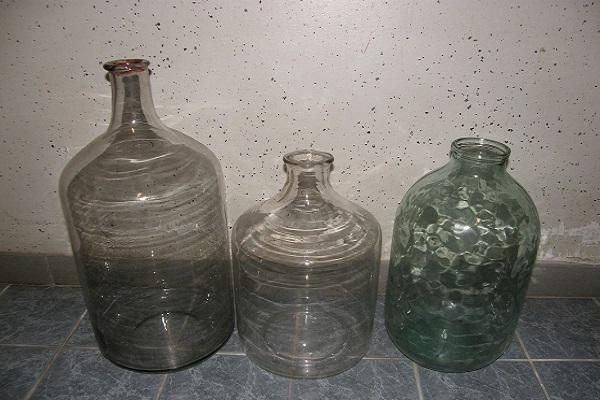
How to properly put a glove on a jar
They take new gloves, get medical ones. The aroma of the drink will suffer if you put on a rubber household product. The material it is made of smells strong.
So that the glove, put on the bottle, does not burst from the pressure of carbon dioxide, it is pricked with a needle. The number of punctures depends on the volume of the fermentation tank.
| Volume (L) | 1-2 | 3-25 | >25 |
| Number of punctures (pcs.) | 1 | 2 | 3-5 |
A puncture is made with a thin sewing needle. Prick your fingertips. The operation is performed when the glove is inflated, fingers spread out in hello. For tightness, the area around the neck is fixed with tape or tightly tied with a lace.
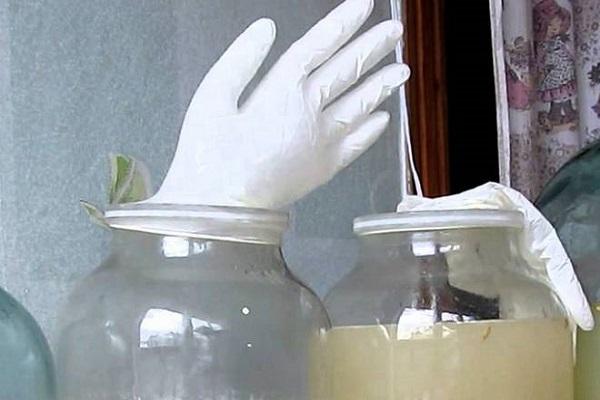
Making wine with a glove at home
Apples grow in Siberia and southern Russia, so a simple recipe for apple wine is especially relevant:
- twist the fruits without a core in a meat grinder;
- Pour mashed potatoes into a bucket;
- for each kilogram of mass, add 150 g of sugar;
- pour the puree into a fermentation container, filling ⅔ of the volume;
- Tie the neck of the bottle with a napkin;
- Shake the container for 4 days, stirring the mass and the foam formed on it;
- on the 5th day, strain the juice through cheesecloth, pour into a prepared bottle, send the juice squeezed from the flesh there;
- for 1-1.5 months put the bottle in a dark, warm place, put a glove on the neck;
- when the glove is deflated, remove the liquid from the sediment using a thin tube;
- Pour young apple wine into bottles, remove for 3 months in a cool place.
In regions where grapes grow, the recipe for a delicious grape drink is popular. For homemade wine, sweet varieties are taken, sour berries are allowed to brew for moonshine. How to prepare raw materials is described above.
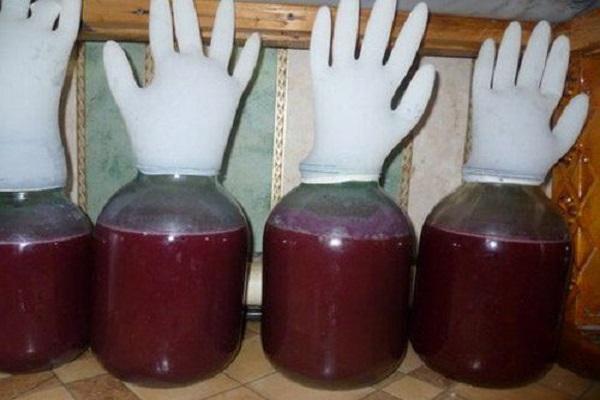
The juice, along with the skins, is poured into a plastic container. For about 4 days, it should stand in a warm place, ferment. A cap will form on the surface. It must be heated 2 times a day. Mix the mass by hand or with a wooden stirrer.
On the 5th day, important work is done - the juice is separated from the cake. Colanders, funnels, plastic and glass containers, gauze are used. As a result, wort is obtained. For every 10 liters add to it:
- water - 2 l;
- sugar - 2 kg.
Water is taken not boiled, without impurities. It is poured all into the wort, and half of the total volume is poured into sugar. Mix everything well. The sugar crystals must dissolve completely.
The billet is poured into fermentation tanks, filling them by 70%.
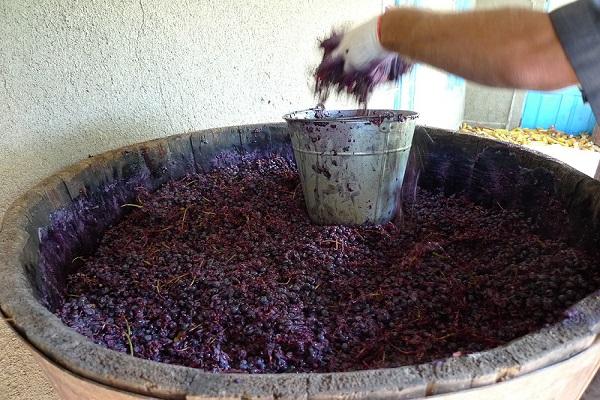
On each bottle of wort, put on a medical glove, prudently pierced with a needle. Containers with fermenting wort are kept in a room where the air temperature is 20-28 ° C. Wild yeast works well in this temperature range.
The active fermentation process takes about 3 weeks. On the 10th day, add a second portion of sugar to the wort - 1 kg for every 10 liters. By the end of the third week, the active fermentation phase will end. External signs will speak about this:
- the wort will brighten;
- sediment will appear at the bottom;
- the glove will deflate.
In order not to spoil the taste of young wine, it is drained from the lees. A thin silicone tube is used. The bottle is placed on a dais. The tube is lowered into the container. Its end is placed 2-3 cm from the sediment. The lower end is lowered into the container below. The wine collected in a clean container is taken to a cool room (10-16 ° C).
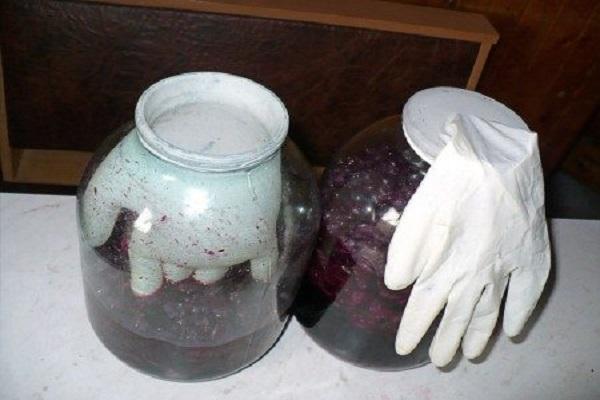
Winemakers use a cellar to ripen young grape wine. It stands there for 2-3 months. Sediment will inevitably appear at the bottom. Wine is removed from it twice:
- a week later;
- in a month.
Already by the new year, you can try a drink prepared at the end of summer. But it is better to postpone the tasting until spring.
Homemade grape wine tastes better after 6 months.
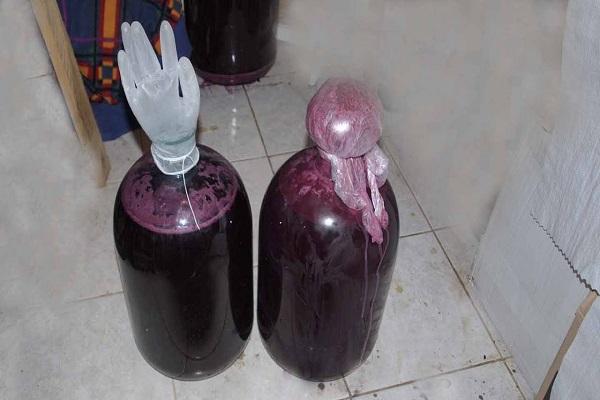
Popular questions
In the process of making homemade wine, novice winemakers have questions. They are standard. The answers are below.
Do I need to pierce the glove?
If the wort is small (1-2 l), and the glove is XL, then it is not necessary to pierce it. For fermentation, no more than 70% of the container volume is poured into the container, so the volume of the glove and the free space in the can is enough for the carbon dioxide released.
Oxygen is leaking through the holes?
During fermentation, air does not enter the hole due to the pressure of carbon dioxide. It is higher than atmospheric. After the end of the process, a small hole is compressed, oxygen does not pass inside. A correctly worn glove rises after 4-12 hours.

What to do if the glove on the can is swollen?
Remove the elastic seal for 2-3 minutes so that it does not burst. During this time, oxygen will not trigger oxidative processes in wine. Quickly make additional holes in the glove, put it back in place and fix the area where the glove is attached to the neck.
Why is the glove pulled inward?
The situation requires analysis. There are several reasons why the elastic closure pulls inward:
- there is a gap between the glove and the neck;
- unstable room temperature;
- the fermentation process is weak;
- the wort is infected with mold;
- the wine is ripe, fermentation has stopped.
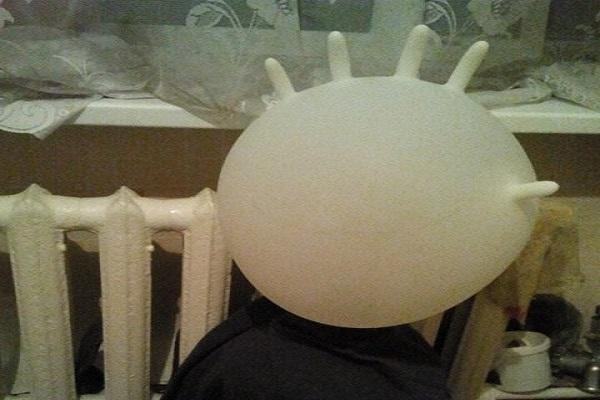
What to do if a wine glove bursts or falls off?
It is not scary if the fermentation tank was open for less than a day. You need to put on a new glove on the bottle. It flies off due to excess pressure during active fermentation and the lack of additional attachment. With increased pressure, strong sealing at the neck, absence or insufficient number of holes, the glove bursts.
Problems with the elastic seal do not arise if the winemaker regularly monitors the processes taking place in the fermentation tank.




